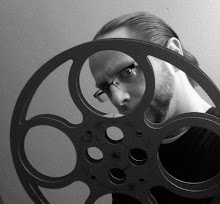There are two common catchphrases in television news which
many in that business will often deny ever coining. The first, if it bleeds it leads…means that death
and destruction will always be the lead story of any newscast. The second, never let the truth get in the way of a good
story…means that the truth can be twisted or altered or omitted if it means
getting a good story on the air. NIGHTCRAWLER is a film which embraces and
examines both phrases, but that’s only part of its story.
Lou (Jake Gyllenhall) breaks into the world of free-lance
television news journalism (called stringers), where he excels at rushing to a
crime or accident scene to capture footage and sell it to the highest bidder.
He develops a working relationship at a struggling news station managed by Nina
(Rene Russo), and takes on the overnight beat while competing with a fellow
stringer (Bill Paxton).
NIGHTCRAWLER is a film of two intertwining parts. The first
being Lou’s meteoric rise through the ranks as he fine-tunes his skills, and
the second being the lengths that journalists, both rookies and veterans, will
go through to get that lead story before anybody else. The decisions that both
Lou and Nina make border upon questionable to disgusting to a hot-topic of
debate in any journalistic ethics class; from manipulating crime and accident
scenes, omitting facts, and flat-out fibbing…NIGHTCRAWLER is a film that will
certainly be discussed and debated and its fascinating to see the characters
weave that tangled web.
But NIGHTCRAWLER doesn’t spend all of its time standing at
the front of a lecture hall. At the heart of everything is Gyllenhall’s Lou,
who is one of the most unlikeable characters ever to grace the screens. He is a
bottom-feeder when we first meet him and he remains a bottom-feeder throughout
the film. He doesn’t grow or learn any morals as a character, but what he does
learn he does through his growing power and success. On top of that, Lou is
basically a soul-less man. He communicates to people through catch-phrases and
slogans he reads online, and his barrage of factual dialogue against his
co-workers is as cold as ice. Director Dan Gilroy doesn’t want us to like him,
but he does want us to be fascinated by him, and in that he succeeds greatly.
Another common catchphrase in the biz is nothing good ever happens after midnight.
Lou spends all of his working time after-hours when the bloodiest crimes and
accidents happen, and this gives Gilroy the opportunity to film some stunning
night-time shots. The underground of Los Angeles is shown as ugly and beautiful;
other-worldly but very real.
Jake Gyllenhall sells the character with his odd mannerisms,
sunken-eye look and just plain-old great acting. There is a constant creepiness
to him which gets under your skin but you somehow want more of it. Rene Russo
seems more inspired than she’s been in years, and Bill Paxton makes good use of
his limited time.
After a shocking climax and the eventual wrap, some viewers
may feel a little frustrated because a certain character didn’t get what they
deserved, but that may be Gilroy’s statement on the business that NIGHTCRAWLER
explores. There are no real heroes in this film, and there is certainly no one
to love…but it stands as a twisted version of the little-engine-that-could, and
a way to make us really think about what we see on TV every night.
BOTTOM LINE: See it














